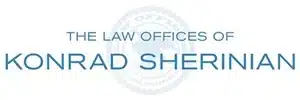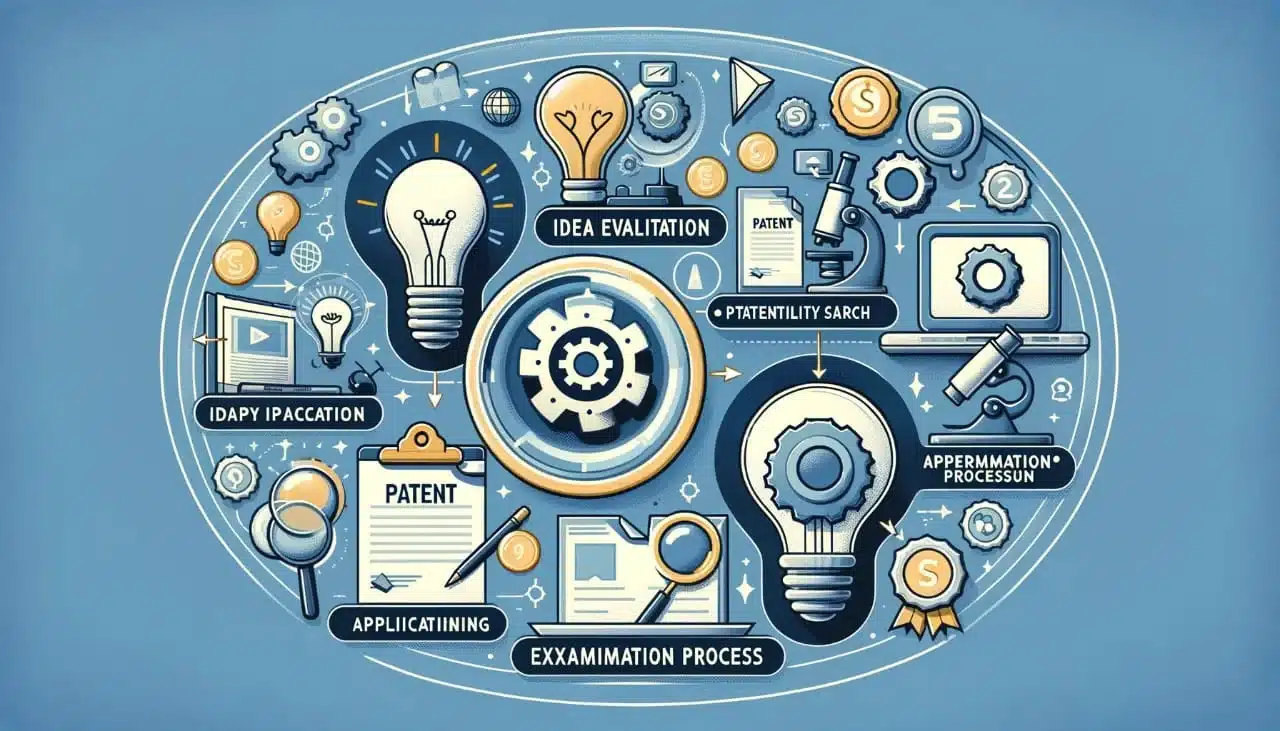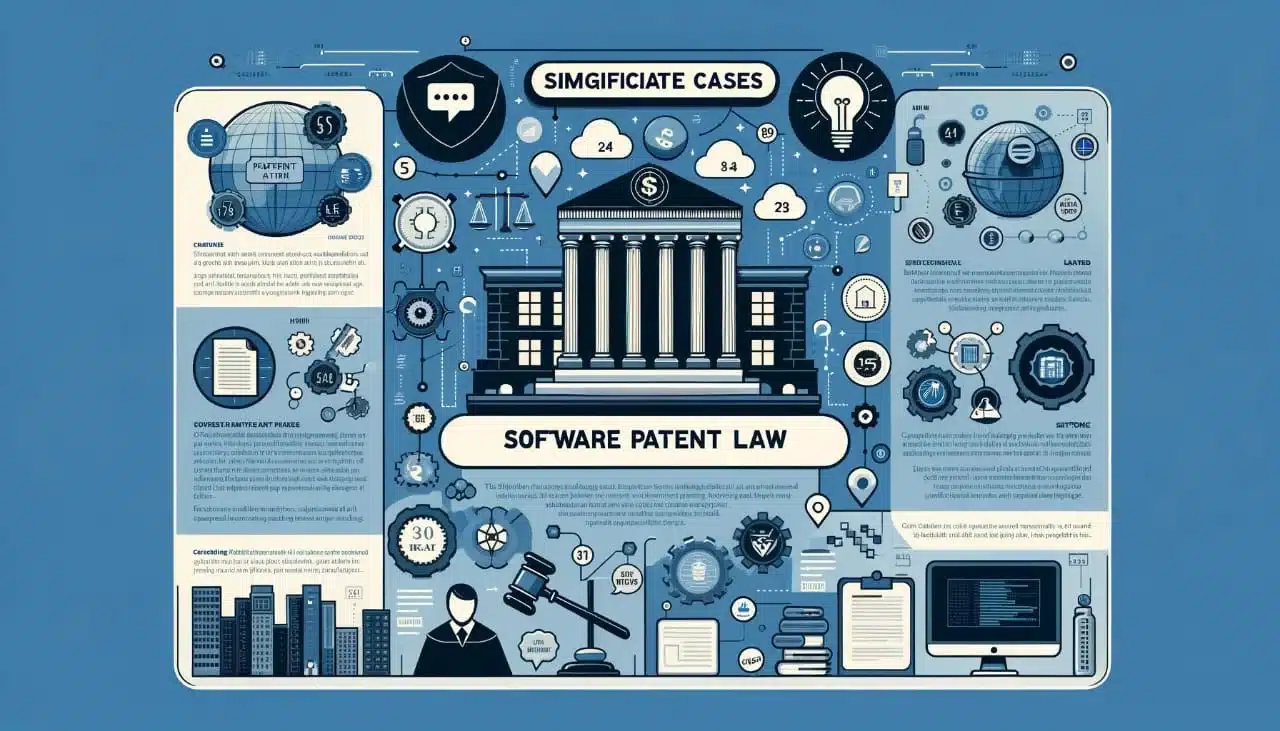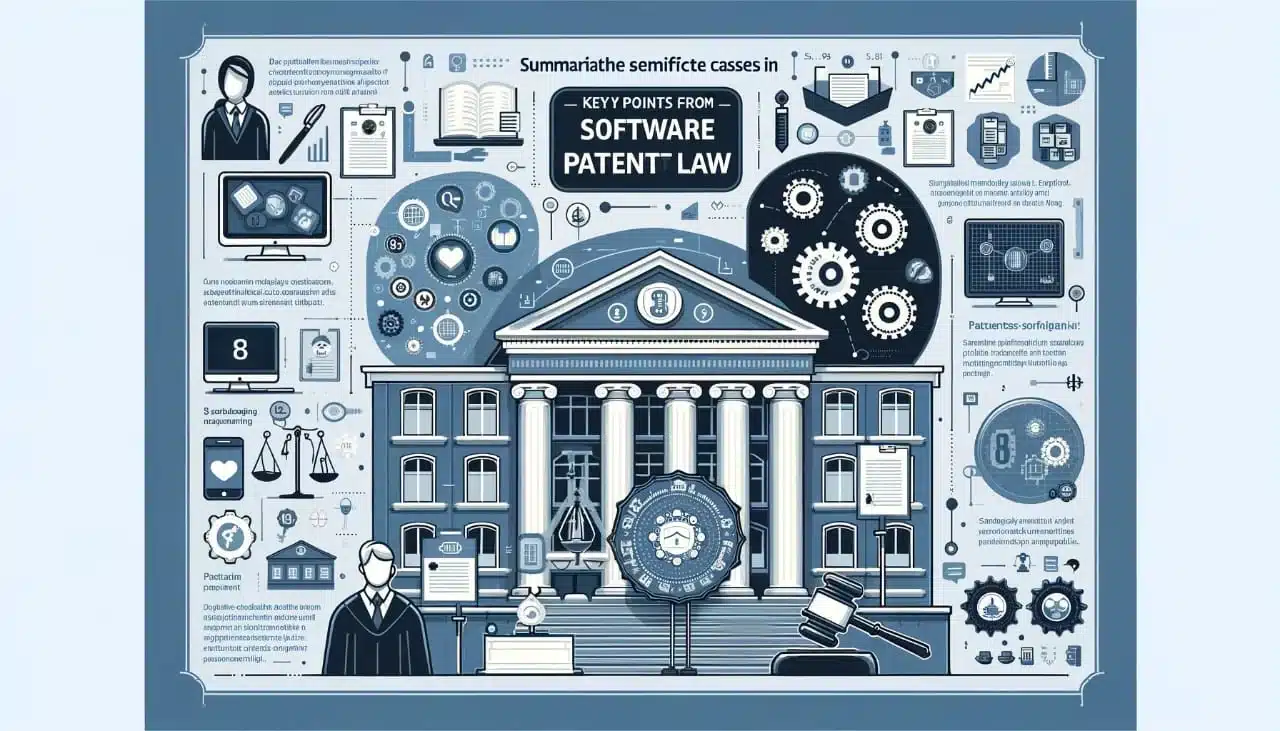Introduction: The Quest for Software Patentability
“Can you patent software? This question isn’t just theoretical; it’s a practical concern that impacts innovators and tech entrepreneurs worldwide. As digital creations become increasingly central to our economic landscape, understanding the intricacies of software patentability is crucial. The journey to patenting software intertwines with legal, technical, and strategic domains, offering a unique challenge to those seeking to protect their digital innovations.”
In this comprehensive guide, we’ll explore the facets of software patenting, from the basics of eligibility to the complexities of legal processes, illustrated with real-world examples and expert insights. Join us as we navigate the landscape of software patent protection, ensuring you have the knowledge to safeguard your innovative creations.
What Makes Software Patentable?
Navigating the intricacies of software patentability begins with understanding the core criteria that define whether a piece of software can be legally protected under patent law. At the heart of this exploration is the distinction between mere abstract ideas, which cannot be patented, and innovative software solutions that provide a concrete technical benefit or solve a specific problem in a novel way.
Criteria for Software Patents
- Novelty: The software must present a new solution or method that has yet to be disclosed to the public. It should refrain from replicating existing solutions in the public domain, underscoring the importance of bringing a fresh perspective to the table.
- Non-Obviousness: Beyond being new, the software should exhibit a leap in thinking that could be clearer to others skilled in the same field. This element often distinguishes patentable software from mere enhancements or iterations of existing technologies.
- Utility: The software must serve a practical purpose, offering a tangible solution or improvement in its respective domain. This functional aspect ensures that the software has a real-world application and is not merely a theoretical concept.
Considerations for Software Patents
- Technical Aspect: The software must demonstrate a technical contribution or effect, showing how it operates within its environment to perform a function that is not just an abstract idea.
- Legal Landscape: Understanding the legal nuances in different jurisdictions is crucial, as the laws and interpretations of what constitutes patentable software can vary significantly across countries and regions.
- Documentation and Disclosure: Thorough documentation of the software’s development process, functionality, and application is essential to establish its patentability and defend it against infringement claims.
The Process of Patenting Software
Navigating the path to a software patent involves several critical steps, each requiring careful attention to detail and adherence to legal standards. Let’s break down this journey into manageable phases:
- Idea Evaluation and Invention Documentation
Before embarking on the patent process, assess your software to ensure it meets the criteria for patentability. Document every aspect of your invention, including the code, functionality, and unique features that set your software apart.
- Conduct a Patentability Search
Engage in a comprehensive search to identify existing patents and public disclosures that may resemble your software. This step is crucial to determine the novelty and non-obviousness of your invention, which are critical factors in patent eligibility.
- Prepare and File the Patent Application
With the assistance of a patent attorney, prepare a detailed application that thoroughly describes your software invention. This document should include drawings, flowcharts, and a written description explaining your software’s functionality and innovation.
- Patent Examination Process
Once the application is filed, it enters the examination phase, where a patent examiner reviews the submission for compliance with legal standards, including novelty and non-obviousness. Be prepared to communicate with the examiner and amend your application to clarify your invention’s patentability.
- Addressing Office Actions
During the examination, the patent office may issue office actions, which are official communications detailing any objections or requirements for further clarification. Responding accurately and timely to these actions is pivotal in moving the process forward.
- Patent Grant
If the examination concludes favorably, your software invention will be granted patent protection. This grant is the culmination of your efforts, providing you with exclusive rights to your software and the ability to prevent others from using, selling, or distributing it without your permission.
Expert Guidance from The Law Offices Of Konrad Sherinian, LLC
Navigating the legal nuances of patenting software is a complex endeavor that demands specialized knowledge and experience. With the Software Patent Attorney expertise at The Law Offices Of Konrad Sherinian, LLC, you can confidently traverse this intricate process. Our dedicated team ensures that every legal and technical detail of your software patent application is meticulously addressed, securing the comprehensive protection your innovation deserves.
Software Patents in the U.S.: A Legal Overview
The United States stands at the forefront of technological innovation, with a legal system that has developed sophisticated mechanisms to protect the intellectual efforts of software developers and companies. Understanding the framework for software patents in the U.S. is vital for anyone looking to navigate the complexities of intellectual property in the tech industry.
The Foundation of Software Patenting
In the U.S., the basis for software patenting is established in the Patent Act, which protects “any new and useful process, machine, manufacture, or composition of matter, or any new and useful improvement thereof.” While the Act doesn’t explicitly mention software, the courts and the United States Patent and Trademark Office (USPTO) have interpreted these categories to include software-related inventions, given they meet certain conditions.
Eligibility Criteria
Software must meet specific criteria to be patentable in the U.S.:
- Novelty: The software must be new, not previously disclosed to the public, or patented.
- Non-Obviousness: It should represent a significant improvement and not be obvious to someone skilled in the field.
- Utility: The software must provide a practical application, solve a problem, or offer a new benefit.
The Alice Corp. v. CLS Bank International Ruling
The Supreme Court’s decision in Alice Corp. v. CLS Bank International was pivotal in U.S. software patent law. It clarified that simply implementing an abstract idea on a computer doesn’t qualify it as patentable. The software must demonstrate an inventive concept that transforms an abstract idea into a patent-eligible invention.
Navigating Post-Alice Challenges
Following Alice’s decision, the scrutiny around software patent applications intensified, requiring inventors to show how their software offers a novel technological solution.
Staying Current
The U.S. software patent landscape is continually evolving. Keeping abreast of legal changes is essential for protecting software innovations.
For more detailed information on the legal aspects of software patents in the U.S., refer to the USPTO’s guidelines on the patent process.
Continuing our exploration of software patents, let’s delve into some of the most noteworthy cases in the field. These landmark decisions have significantly shaped the patent law landscape, particularly regarding software and technology.
Noteworthy Software Patent Cases
The history of software patent litigation is rich with cases that have set important precedents and clarified the application of patent law to software innovations. Here, we review a few famous cases that have profoundly impacted patent law.
Diamond v. Diehr (1981): This landmark Supreme Court case was one of the first to affirm the patentability of software-related inventions. The Court ruled that an otherwise patentable invention does not become unpatentable simply because it utilizes a computer program. The decision in Diamond v. Diehr established that software, when part of a more extensive, innovative process, could be considered for patent protection.
Bilski v. Kappos (2010): In this case, the Supreme Court addressed the patentability of a business method claimed through a computer program. The Court rejected the specific patent application, stating that the process was an abstract idea and thus not eligible for patent protection. Bilski v. Kappos clarified the limits of patentability, especially for software and business methods, setting a precedent that abstract ideas implemented on a computer are not patentable per se.
Alice Corp. v. CLS Bank International (2014): Perhaps the most influential recent case in software patent law, the Alice Corp. decision, further defined the boundary between patentable software inventions and abstract ideas. The Supreme Court held that requiring generic computer implementation fails to transform an abstract idea into a patent-eligible invention. This case has had significant implications for the patentability of software and has led to a more stringent examination process for software patents.
Mayo Collaborative Services v. Prometheus Laboratories, Inc. (2012): While not directly related to software, this case has impacted the patent landscape, including software patents. The Supreme Court’s decision set a precedent for determining the patent eligibility of processes that involve laws of nature, which has been applied in subsequent software patent cases.
Impact on Patent Law
These cases illustrate the evolving nature of software patent law, highlighting the balance between promoting innovation and preventing monopolization of abstract ideas and fundamental principles. They underscore the necessity of a detailed and technical approach in software patent applications to demonstrate the invention’s specific, tangible, and novel aspects.
Through these landmark cases, we can see how the legal framework surrounding software patents has developed and how important it is for inventors and legal practitioners to understand these nuances when navigating the patent application process.
Continuing with our in-depth exploration of software patents, let’s delve into the crucial aspect of evaluating the need for a software patent. This section explains when and why patenting your software is a strategic move to protect your intellectual property and sustain your competitive edge.
Evaluating the Need for a Software Patent
Deciding whether to patent software is a significant strategic decision that hinges on various factors. It’s not just about legal protection; it’s about understanding the value and potential of your software in the market. Here are key considerations to guide you through this decision-making process:
Assessing the Unique Value of Your Software
- Innovation and Novelty: Consider if your software offers a unique solution or functionality that is not obvious or previously unavailable in the market. The core of patentability lies in novelty and the inventive step that distinguishes your software from existing technologies.
Market Position and Competitive Advantage
- Market Exclusivity: Patenting software can provide exclusive rights to use, sell, and develop the product, preventing competitors from encroaching on your market space. Evaluate the competitive landscape and determine if a patent solidifies your position and offers a strategic advantage.
Long-Term Business Goals and Growth Strategy
- Alignment with Business Objectives: Align the decision to patent with your overall business strategy. Consider how a patent fits into your long-term goals, such as market expansion, product development, and partnerships. A patent can be a valuable asset in negotiations, collaborations, and securing funding by demonstrating the tangible value of your intellectual property.
Cost-Benefit Analysis
- Investment vs. Return: Obtaining a patent involves time and financial investment. Conduct a cost-benefit analysis to weigh the potential return on investment (ROI) against the costs of patenting, including legal fees, filing charges, and maintenance fees over the patent’s lifespan.
Legal Considerations and Compliance
- Adherence to Patent Laws: Ensure that your software complies with the legal requirements for patentability, including being a novel, non-obvious, and applicable invention. Stay informed about the evolving patent laws and how they might affect the patentability of software-related inventions.
Making an Informed Decision
The decision to pursue a software patent should be made after carefully considering the abovementioned factors. Consulting with a patent attorney specializing in software patents can provide valuable insights and help make an informed decision. They can assist in evaluating the patentability of your software, navigating the legal complexities, and developing a strategic approach to protect your intellectual property effectively.
Expertise in Action: Navigating Software Patent Complexity
In the intricate world of software patents, the experience and expertise of your legal team can make a significant difference. At The Law Offices Of Konrad Sherinian, LLC, our approach is grounded in a deep understanding of the technical and legal aspects of software patenting.
Konrad Sherinian, a partner at our firm, has been instrumental in navigating the complex patent landscape, particularly for software-related inventions. His extensive experience in drafting and prosecuting patent applications and his active role in intellectual property litigation reflects a comprehensive skill set that benefits technology companies and inventors alike.
While the primary goal of this blog is to educate and inform about the software patenting process, it’s worth noting that having a knowledgeable attorney like Konrad can significantly enhance the prospects of successfully securing and defending software patents.
For those interested in exploring the depth of experience and the track record of success our attorneys bring, further information can be found on Konrad’s profile page.
Conclusion: Protecting Your Digital Innovations
In the rapidly evolving digital landscape, securing software patents is not just about legal recognition but about safeguarding innovation, ensuring competitive advantage, and fostering continued technological advancement. Software patents play a pivotal role in protecting creators’ intellectual efforts and investments, providing them with the legal tools to defend their work against unauthorized use and infringement.
At The Law Offices Of Konrad Sherinian, LLC, we understand the critical importance of these protections. Our expertise in intellectual property law, particularly in software patents, positions us to offer strategic legal guidance and robust defense of your innovations. With a team led by seasoned professionals like Edward Bi, we are equipped to navigate the complexities of patent law, delivering solutions that protect and enhance the value of your digital assets.
In a world where technology defines the future, partnering with a law firm that comprehensively understands the nuances of software patenting is crucial. We are committed to protecting your digital innovations and ensuring they thrive in the global marketplace.
FAQ’S
What qualifies as software for patent purposes?
Clarify what types of software can be patented, discussing the requirements for patent eligibility, such as novelty, non-obviousness, and utility.
How long does a software patent last?
Explain the duration of a software patent, typically 20 years from the filing date, and what that means for software developers and inventors.
What is the difference between a software patent and a copyright?
Discuss the distinction between patent protection for the functionality of software and copyright protection for expressing ideas in the software code.
Can open-source software be patented?
Address the nuances of patenting software intended to be open-source and how patenting might affect the open-source community.
How much does it cost to patent software?
Provide a range or estimate of the costs of filing and obtaining a software patent, including attorney fees, USPTO fees, and other related expenses.
What is the process for patenting software internationally?
Explain the steps in securing patent protection for software in multiple countries, including using the Patent Cooperation Treaty (PCT) process.
How can I determine if my software is patentable?
Offer guidance on conducting a patentability assessment, including the importance of a thorough prior art search.
What should I do if I believe my software patent rights have been infringed?
Provide advice on the steps to take if someone infringes on a software patent, including potential legal actions.



